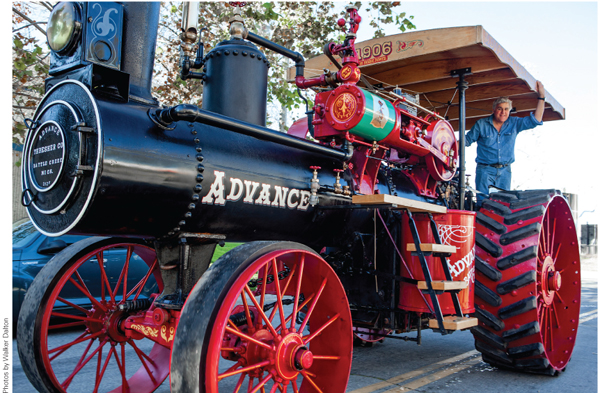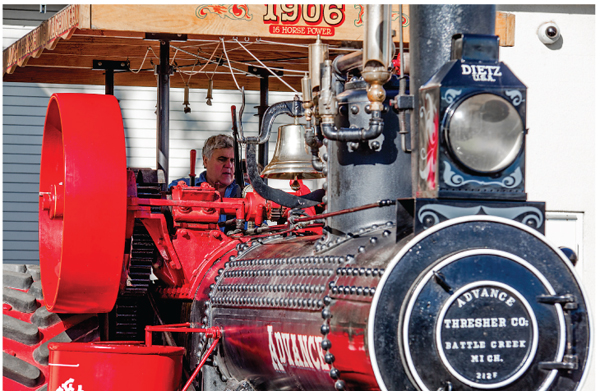Advance steam traction engines turned soil, planted and harvested, hauled, and performed numerous other tough jobs that required power and mobility. Their furiously spinning flywheels ran auxiliary, belt-driven apparatus such as sawmills, all driven by a single, steam-propelled piston that powered tractors to a top speed of about 4 mph. A 1906 Advance engine, all 13 beautiful tons of it, has been lovingly restored by Orman Rawlings, a friend of comedian and steam power enthusiast Jay Leno. Manufactured by the Advance Threshing Machine Co. of Battle Creek, Mich., the engine was featured in an episode of “Jay Leno’s Garage.”

“Four miles an hour may not sound like much, but four miles an hour in this thing will scare you to death,” says the long-time “Tonight Show” host. The engine, rated at 16 hp at 350 rpm, recently pulled a 55,000-lb sled, proving its ability to provide traction for rugged outdoor projects. The engine did get one upfit during the restoration — its boiler is now heated by propane, rather than the coal, wood, or straw that fed the firebox originally. The restored engine resides in the steam section of Leno’s Southern California garage, along with his collection of vintage White, Stanley, and Doble steam-powered vehicles. Leno has a 400-gal. propane tank and dispenser installed on the property to provide fuel for the Advance engine and the garage’s forklifts, as well as the automotive showplace’s barbecue grill.
“This type of engine was built up until 1916,” says the passionate collector in the “Jay Leno’s Garage” episode featuring the restored 106-year-old labor-saving device. “The story handed down has the engine being ordered in late 1905 by Mr. C. Berczyk of Hennapin, Minn. after he and his son were awarded a U.S. Navy contract to supply lumber for ships. Berczyk cleared timber on his 660 acres at the time and used the engine to skid logs to Mill Pond, Minn. During World War I demand for scrap metal was so high that the engine was hidden to prevent scrappers from finding it.”
Leno adds that while hauling a heavy load of logs in 1937, a parted sledge support chain pushed the tractor into a ditch. After several months of repairs, it went back into service. During World War II, it was hidden in the same stand of trees as during World War I to prevent it from being scrapped. After the war the engine went back into service running a shingle mill, using the mill’s scrap wood for fuel.

By 1950 it was in failing condition. Eventually, Berczyk’s great-grandaughter sold it to a J. Balek of Spring Lake Park, Minn., who kept it running until his death in 1990. Leno’s friends, Sonny Rowlands and Orman Rawlings, bought the steamer in 1991 and brought it to California. “The tractor’s lengthy outdoor storage under trees did more damage than good,” says Leno, who in early March performed at the Green Truck Summit & Work Truck Show President’s Breakfast in Indianapolis. “Leaves, rain, and snow down the smokestack caused the lower smoke box and tube sheet to rust beyond repair.”
Leno outlines that the first step in the restoration was to strip the boiler of all fixtures and send it to Dixon Boiler Works in Los Angeles. The lower half of the water drum was replaced, along with all the tubes, and the front tube sheet was replaced. A California pressure vessel inspector was called in to inspect each phase of the rebuild. “Several gears had to be remanufactured or rebuilt, and 87 pounds of bearing Babbit was poured into the bearing caps, then the whole unit was placed in the mill at the Retting Machine Shop in Redlands, Calif. All bearings were aligned and bored to the clearance needed. It was a long haul, but with a lot of hard work on the part of many, the steam-power restoration was accomplished.”
The engine stands nine and a half feet tall and is 104 inches wide and 24 feet long. It weighs a whopping 13 tons and it takes two men to run it. Perhaps better known more for his extensive motorcycle and classic and performance car collection, Leno says his interest and emphasis has shifted to vintage steam vehicles. The Advance engine’s conversion to propane was a nod to the ease of turning the fire on and off, as well as adopting a clean fuel source.
“If you needed something big, this was it,” Leno says of the engine. “Orman did a heck of a job. The boiler was rotten and the gears were chewed. Guys don’t get rich doing these kinds of restorations. It really was a labor of love. I’m so glad to be able to save this engine.” He adds that it takes 250 to 300 gallons of water to fire up the historic implement. An additional 50 gallons travels onboard the tractor in drum storage.
“It’s not exactly rack-and-pinion steering,” Leno observes. Chains turn the front wheels. Further, the two-man operation has one steering and one working the clutch and throttle. There are no brakes at all, “you just throw it into reverse and pull the clutch to get it going the other way.” A hand-cranked lubricator lubes the steam cylinder. There’s also a Dietz steam-generated light that’s being restored. It will eventually ride on top and replace the motorcycle battery that currently powers the light. “For when we go for night drives,” the comedian jokes. Also being restored is a trailer with a hand pump that provides extra water for the boiler.
Leno characterizes the engine’s firebox hatch as the “gates of hell,” and cracks “good steam men have no eyebrows.” And “make sure there’s water on top of the crown sheet. If there’s no water, run away. It’s going to explode.” The engine has a bell, a high-pitched whistle, a middle whistle, and a low whistle to ensure everybody’s paying attention. At 4 mph “a little trip around the block takes about an hour,” but to make those jaunts possible on roadway pavement rubber has been added to the lugged metal wheels.
Leno, who makes frequent personal appearances at trade shows, among them the recent NAHB International Builders’ Show in Las Vegas, comments, “I admire blue-collar workers, people like machinists and builders who know how to build and fix stuff.” The Andover, Mass. native notes there’s a lot more propane could contribute if people would educate themselves about its benefits, especially regarding its contribution to a healthier environment. “It’s hard to understand why it doesn’t catch on more strongly,” he says.
Regarding perceptions held by many, he recalls a “Jay Walking” segment on the “Tonight Show.” The pre-recorded segments had Leno interviewing people strolling in public areas about various topics. Most responses were outrageously incorrect. “I asked if there was a miracle odorless, colorless gas that was cheap to use for cooking and heating, would you use it in your home. Nearly everybody responded, ‘No, it sounds dangerous. I would never use it.’ I have no idea where they think the flame on the top of their stove comes from.”
To view the “Jay Leno’s Garage” episode featuring the 1906 Advance steam engine, visit YouTube.com/user/JayLenosGarage and scroll down to Steam Powered Vehicles. —John Needham

